Last updated: December 8, 2024
Article
50 Nifty Finds #29: Traditions in Clay
In the 1920s and 1930s the National Park Service (NPS) began to focus on education as a key part of its mission. New exhibits were created in NPS museums throughout the country. They often featured artifacts and information about Native Americans whose traditional lands had become part of national parks. Although the exhibit content was often culturally insensitive, paternalistic, and racist, many Native Americans, like Legoria Tafoya of Santa Clara Pueblo, were hired to demonstrate their traditional cultural practices or make examples of pottery, paintings, clothing, tools, or other items for park exhibits. Most of those objects have become part of NPS museum collections where they continued to be appreciated, studied, and reevaluated as more voices become part of the conversations around them.

Legoria Velarde Tafoya
Legoria Velarde was born at K'apovi (Santa Clara Pueblo), New Mexico, on April 14, 1911. She was the eldest daughter of Herman and Marianita Chavarria Velarde. She and her sisters, Rosita, Pablita, and Lucaria (known as Jane), grew up to be talented artists. Legoria attended St. Catherine's Indian School in Santa Fe. At 18, she married Pasqual Tafoya, who went on to serve two terms as governor of Santa Clara. Together they had five children: Emelio, Celestina (known as Celes), Michese, Miguel, and Thelma Sue. Celes became a celebrated potter in her own right, often collaborating with her mother.
In 1930 Tafoya's grandmother began to teach her to make pottery. She molded animal figures such as lions, turtles, bears, and birds as she learned to make pottery bowls and jars. She helped support her family by selling them to tourists who came to the pueblo. Their popularity encouraged her to exhibit her work at the Santa Fe Indian Market in 1940. She earned a blue ribbon that year for a plain polished bowl. Tafoya became known for her carved blackware bowls, jars, and candlestick holders. She continued to exhibit her art around the country, winning more awards for her work.
For most of her career, her pottery was sold at the Enchanted Mesa Indian Arts, a shop near Albuquerque, New Mexico. She was one of the first Santa Clara Pueblo artists who had a personal biographical statement in the brochure that accompanied her work. Much of what has been repeated about her comes from those brochures. Tafoya’s pottery is part of many museum collections, including Bandelier National Monument, National Museum of the American Indian, Indian Arts Research Center, University of Michigan Museum of Art, Bowers Museum, and others. It is also in many private collections in the United States, Germany, Ireland, England, Canada, and Peru.
Legoria Tafoya died in February 1984. After her death, Celes began making pottery with her own daughter, Evelyn Aguilar.
An Artist in Action
In 1939 Tafoya demonstrated the traditional steps used to create her pottery vessels for an exhibit at Bandelier National Monument. Natt N. Dodge, junior naturalist at the NPS Southwestern National Monuments (SWNM), filmed and photographed Tafoya demonstrating her traditional process. The June 1939 SWNM monthly report noted,
Natt took movie shots of Legoria Tafoya at the Santa Clara Pueblo as she gathered clay and shaped some of her famous Santa Clara black jars. He took many stills which are to go into the museum case showing various steps in the making of a jar.
Tafoya also made nine objects—ranging from an unformed ball of clay to a finished pot—for exhibit at Bandelier. They are now part of Bandelier's museum collection.
Twelve of Dodge's photos of Tafoya from that day in June 1939 are part of the NPS History Collection. Black-and-white prints from Dodge's series can be found in other collections; these may be the only hand-colored versions. Although the artists who colored the prints are unknown, they could have been employees at the NPS Western Museum Laboratory (WML) in Berkeley, California. Artists there—many of them women—colored prints, glass lantern sides, and other media in WML's lantern slide department. The result was a stunning series of images that capture details of Tafoya's clothing and home as well as her art.
Dodge's photos, seen below, document Tafoya's traditional pottery-making process.
Step 1: Digging the Clay
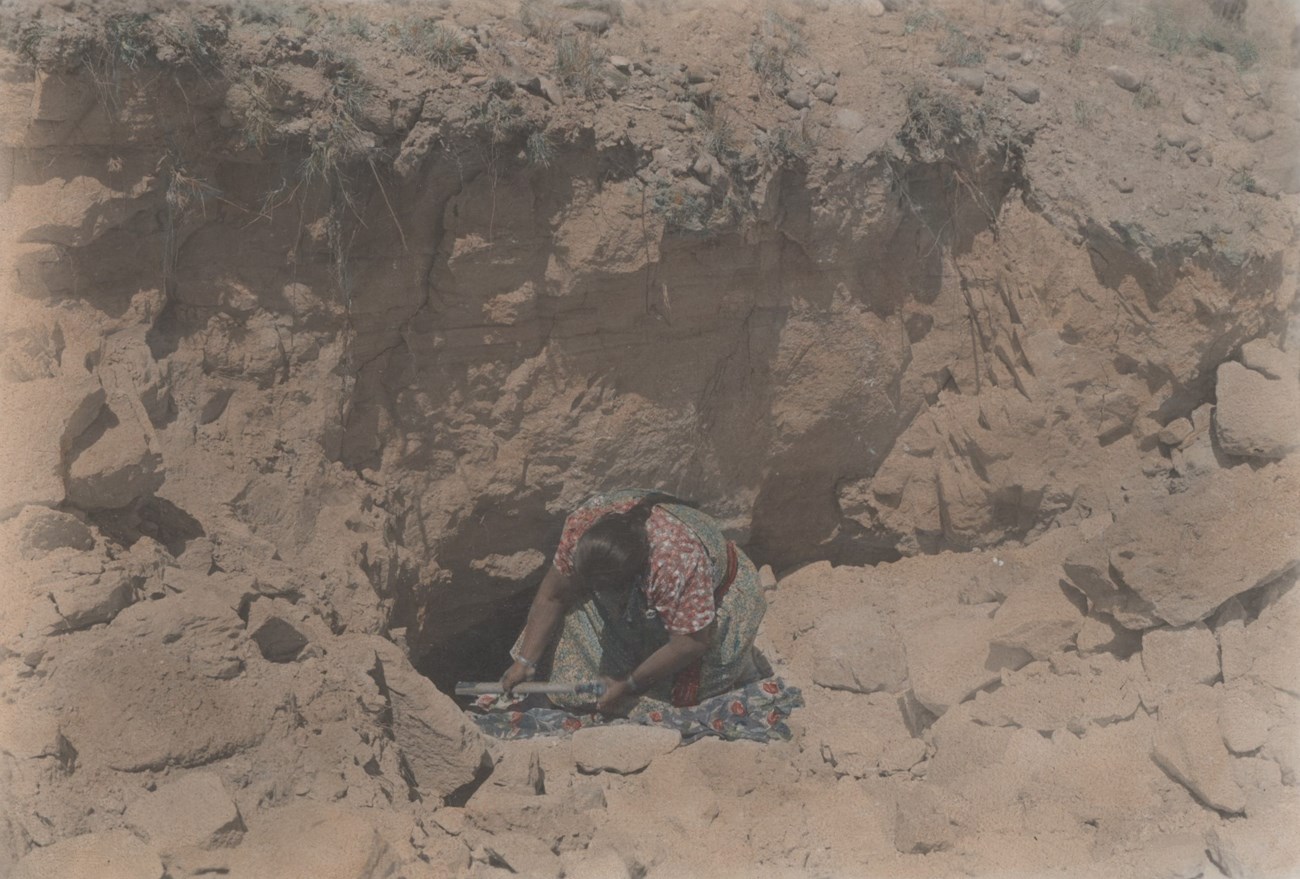
Step 2: Pulverizing the Clay
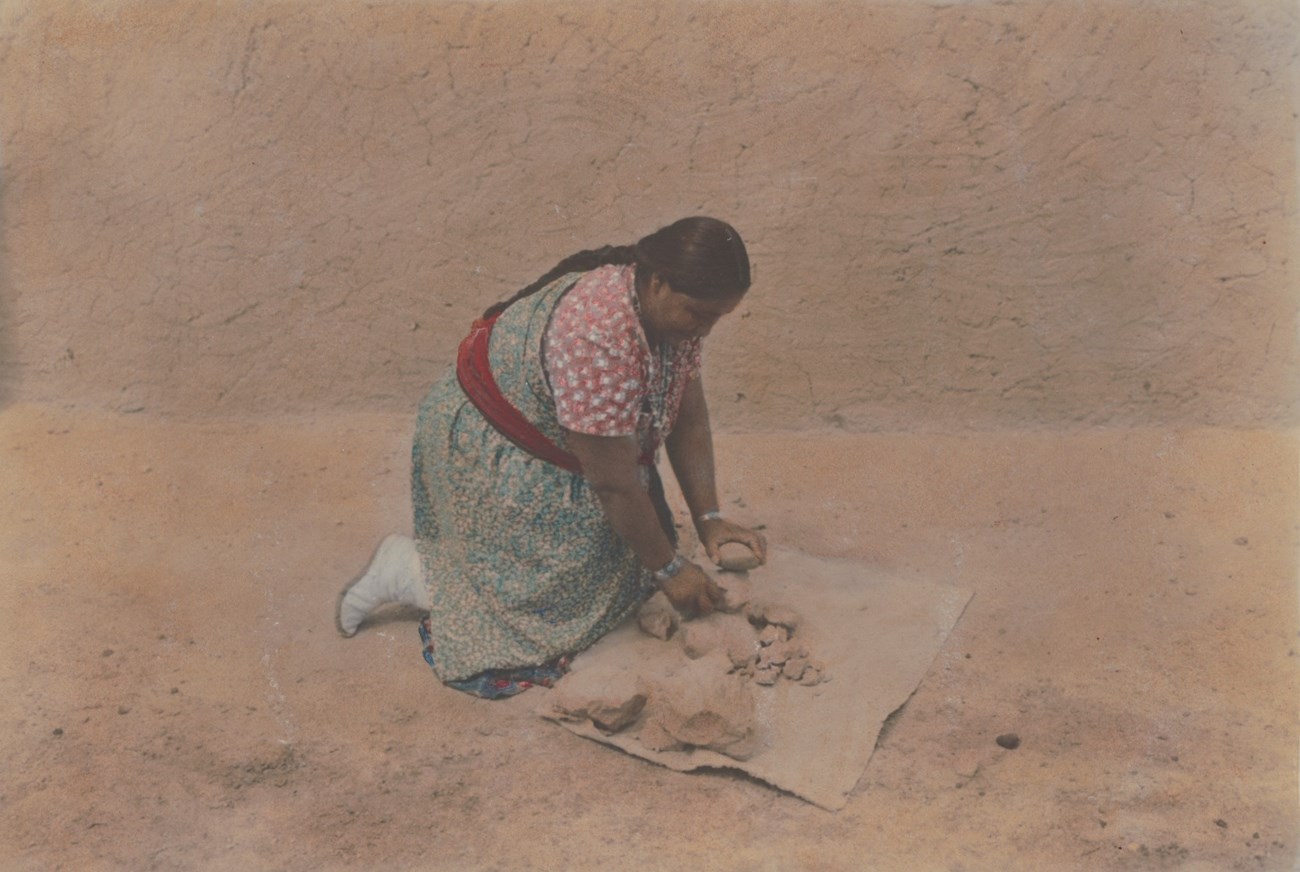
Step 3: Kneading and Tempering Clay
At Santa Clara Pueblo, volcanic ash and other materials are used to temper the clay so that it fires evenly without cracking.
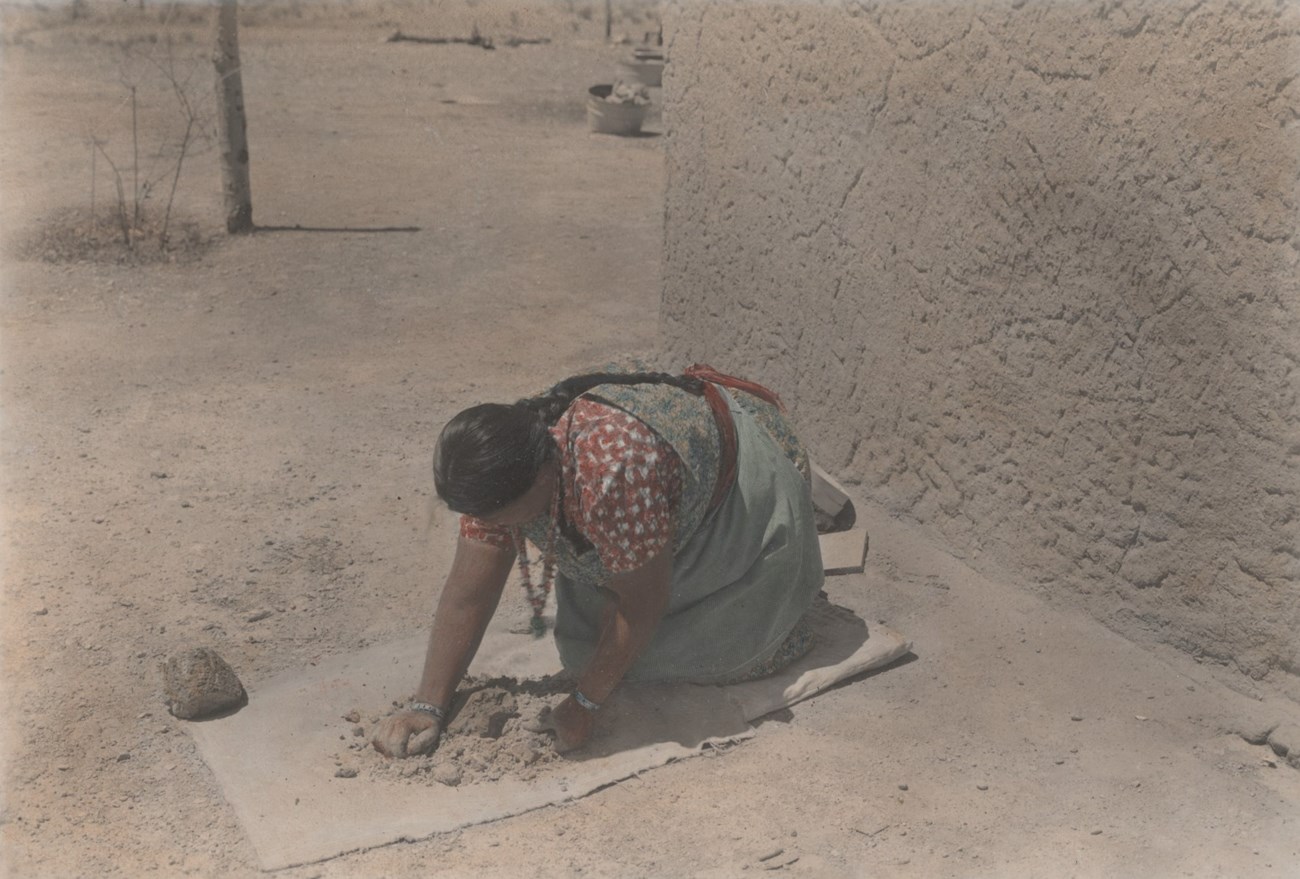
Step 4: Making the Bottom of the Pot
The clay is usually left to rest overnight, then a piece is shaped into a ball and flattened into a disc. It becomes the base of the pot.
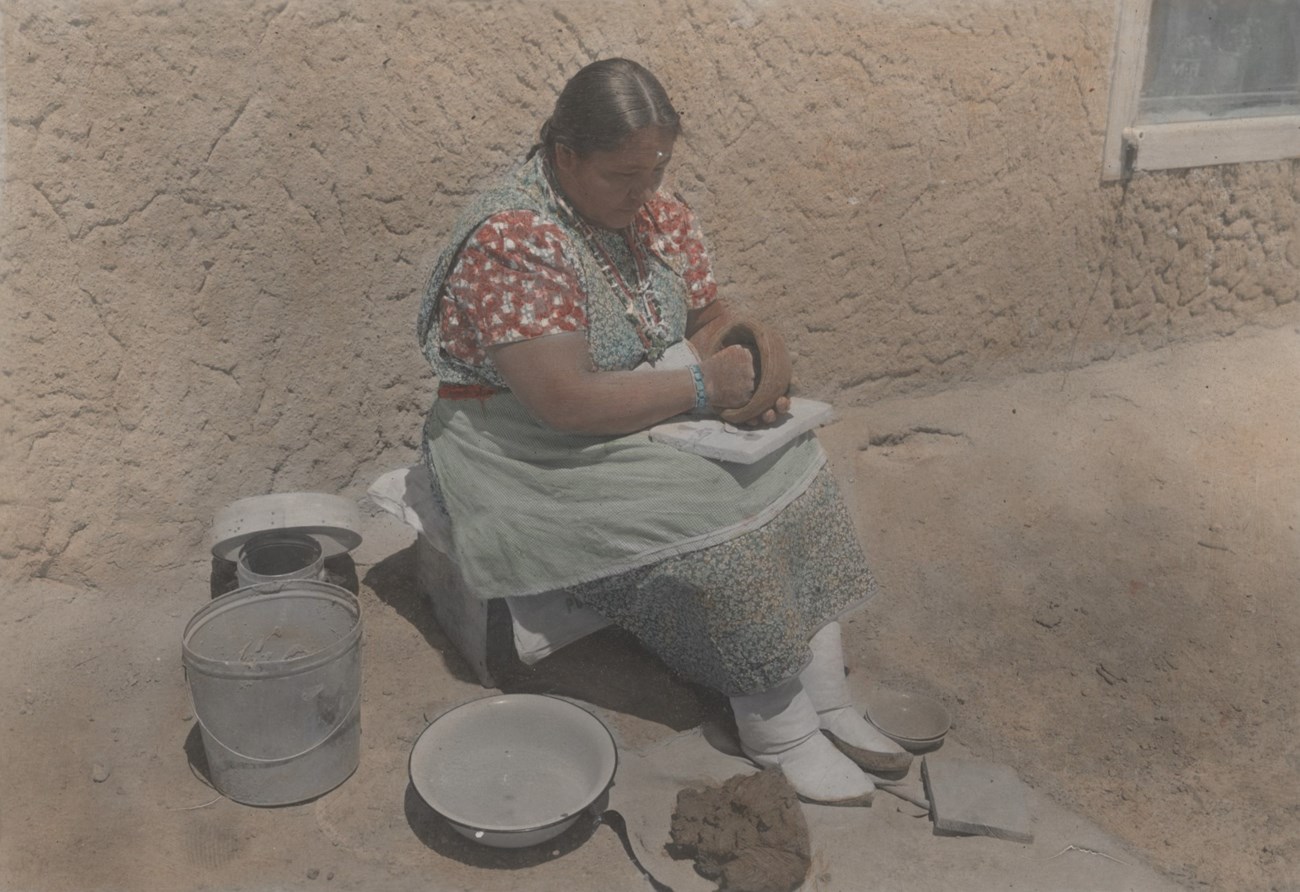
Step 5: Coiling
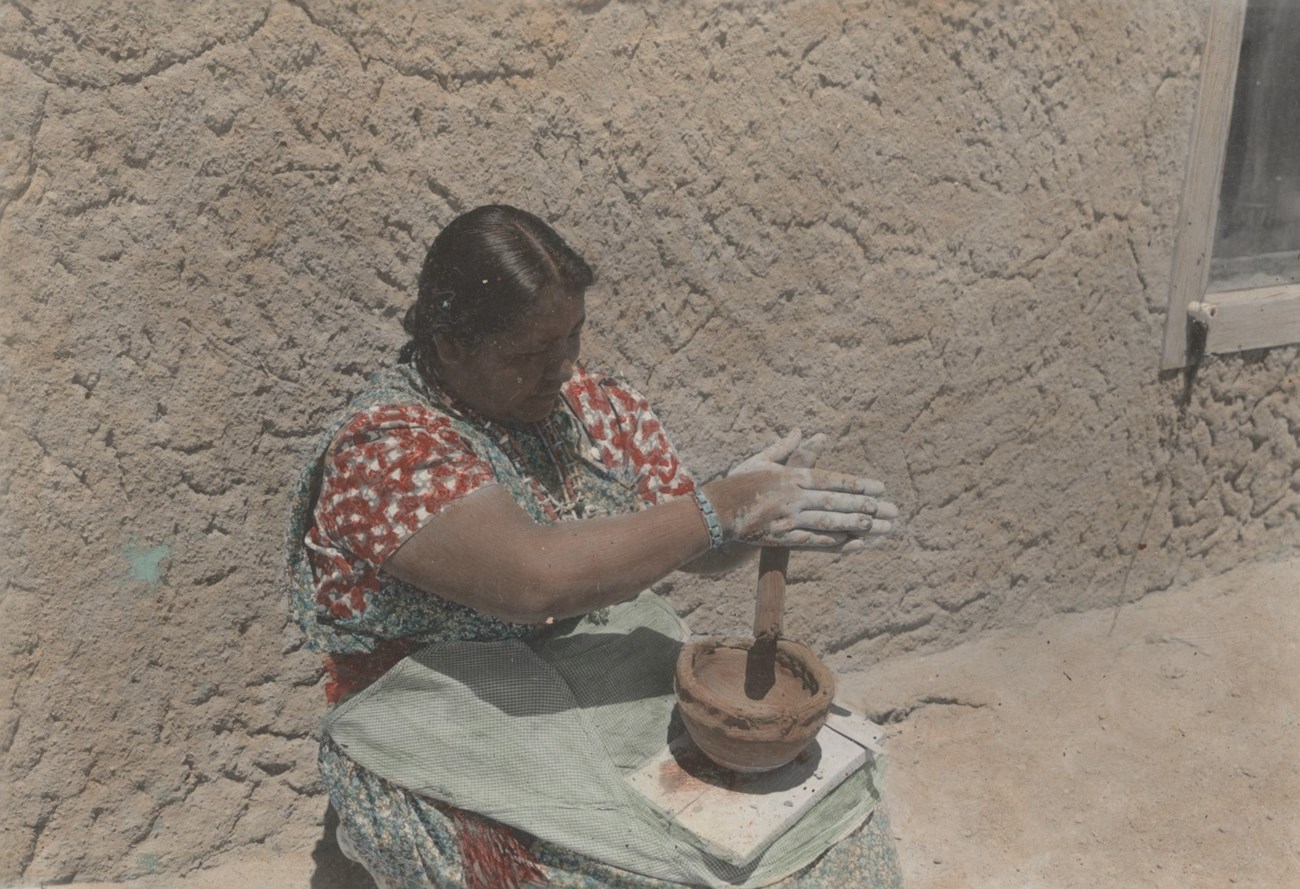
Step 6: Thinning and Smoothing by Scraping
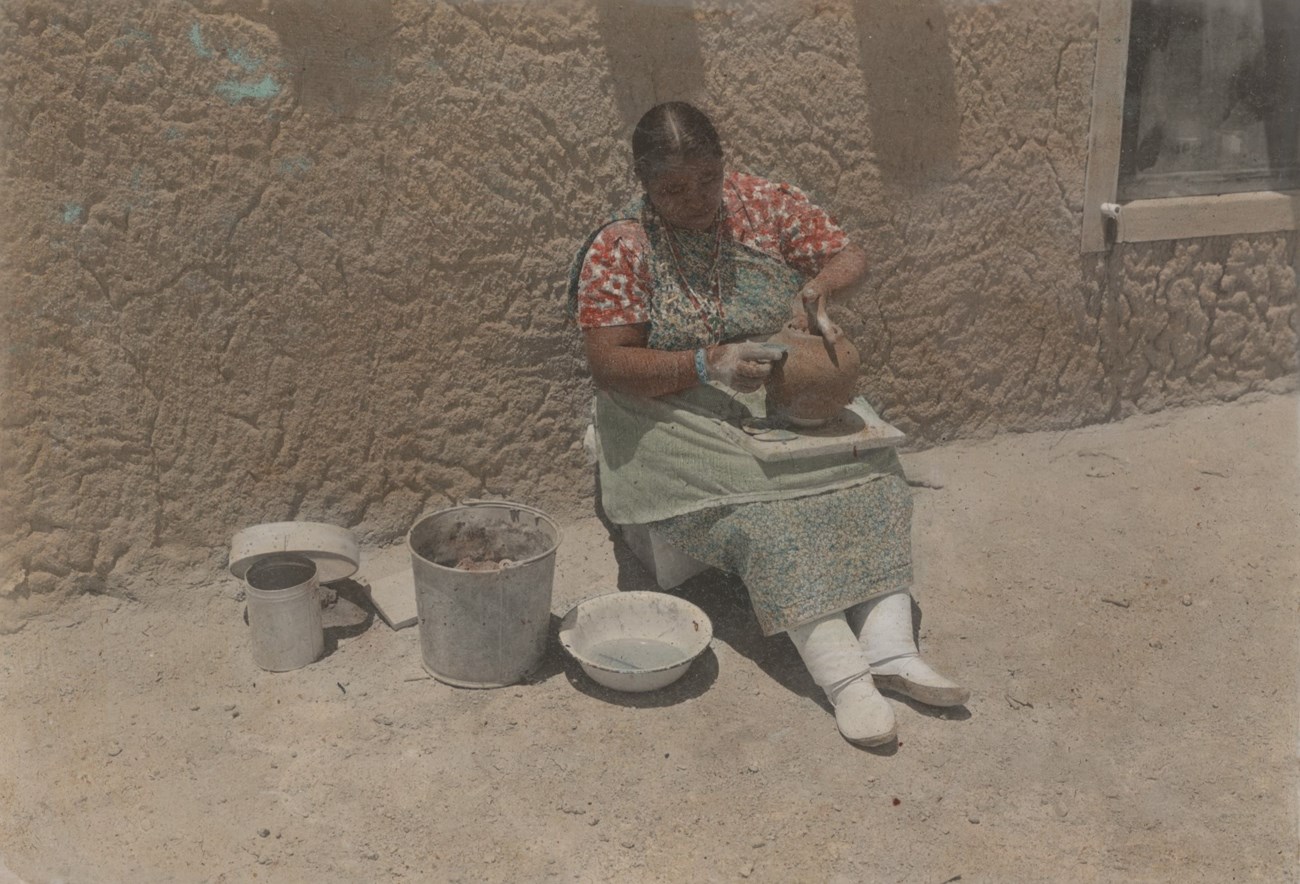
Step 7: Thinning and Smoothing by Knife
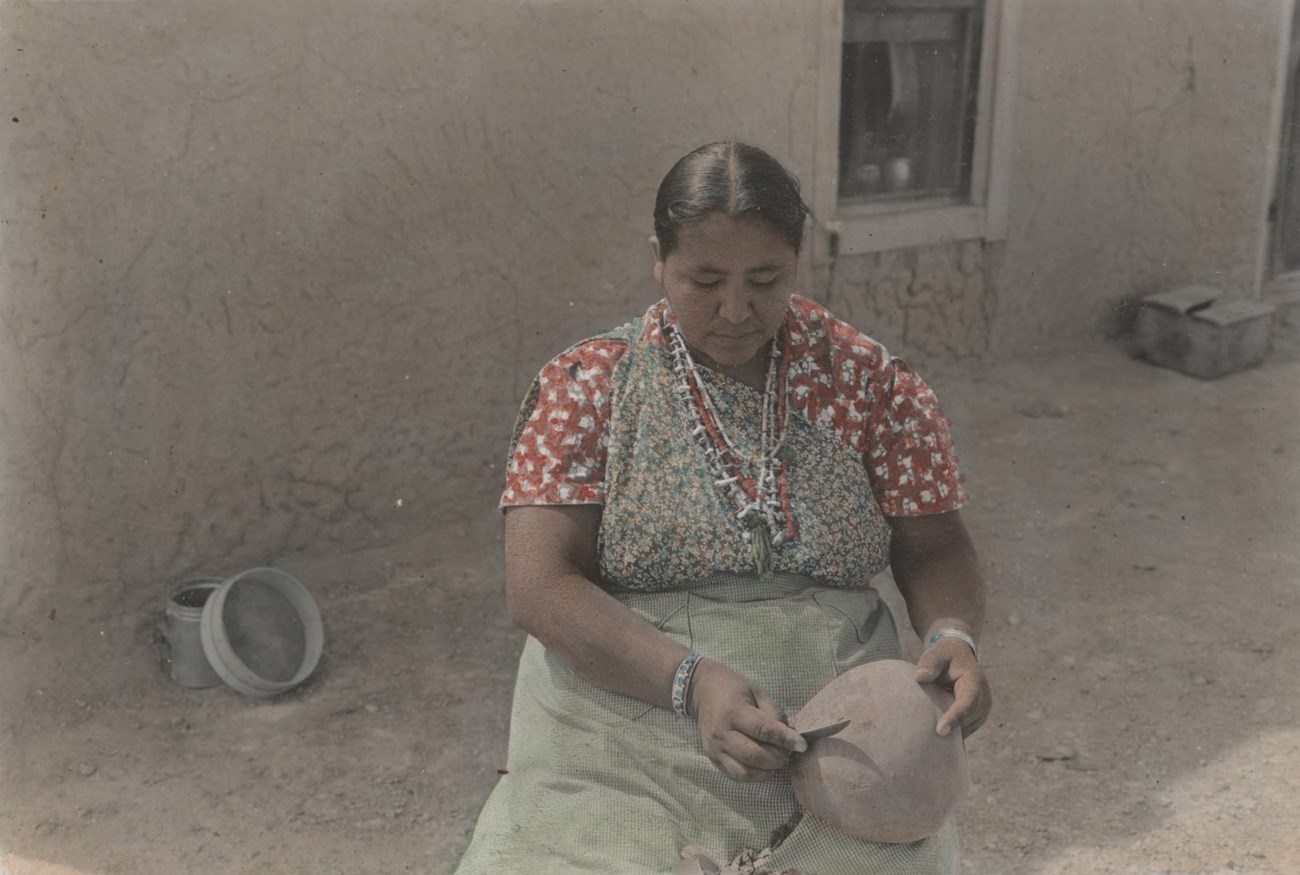
After the desired shape and thickness is achieved, the pot is dried slowly to prevent cracking. Once it has dried, the next stages can begin.
Step 8: Burnishing
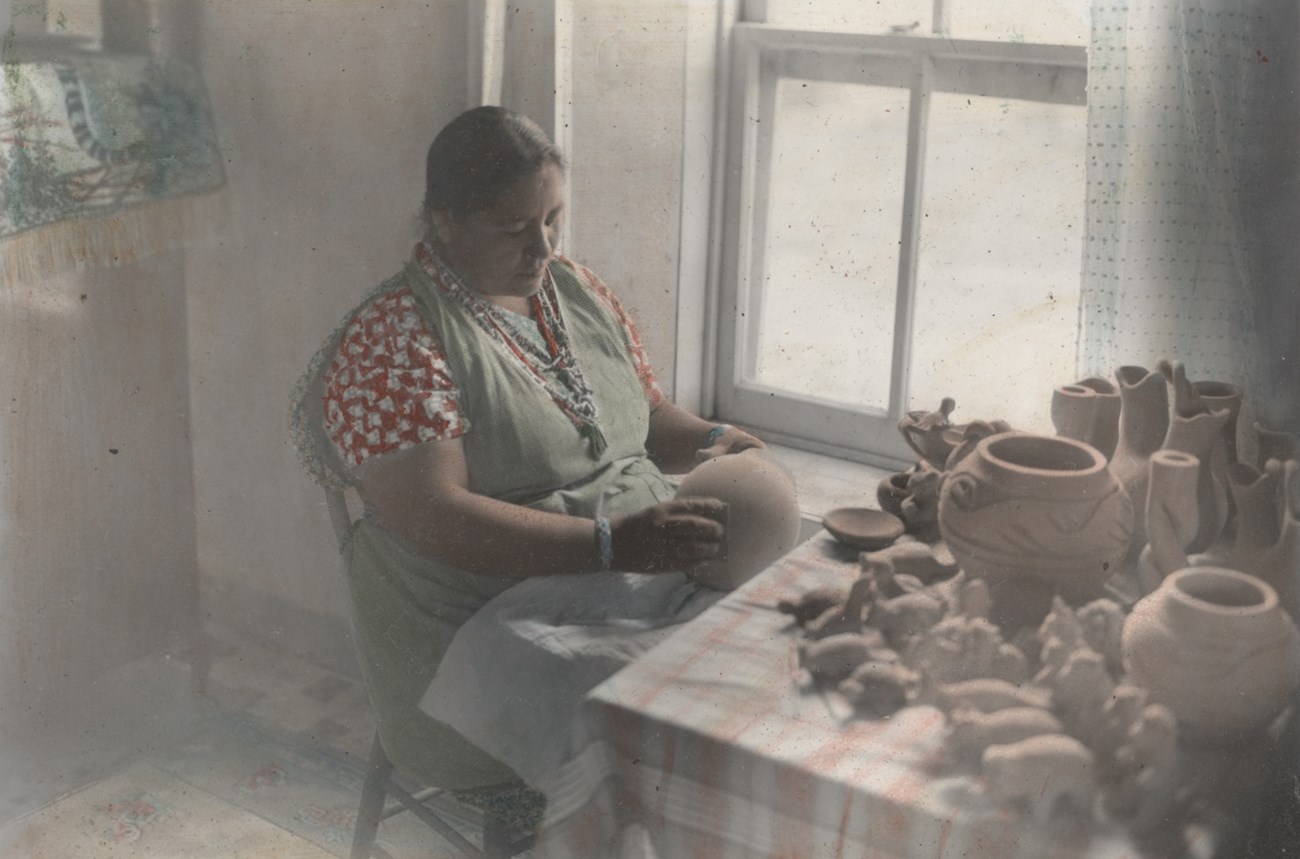
Step 9: Applying Slip
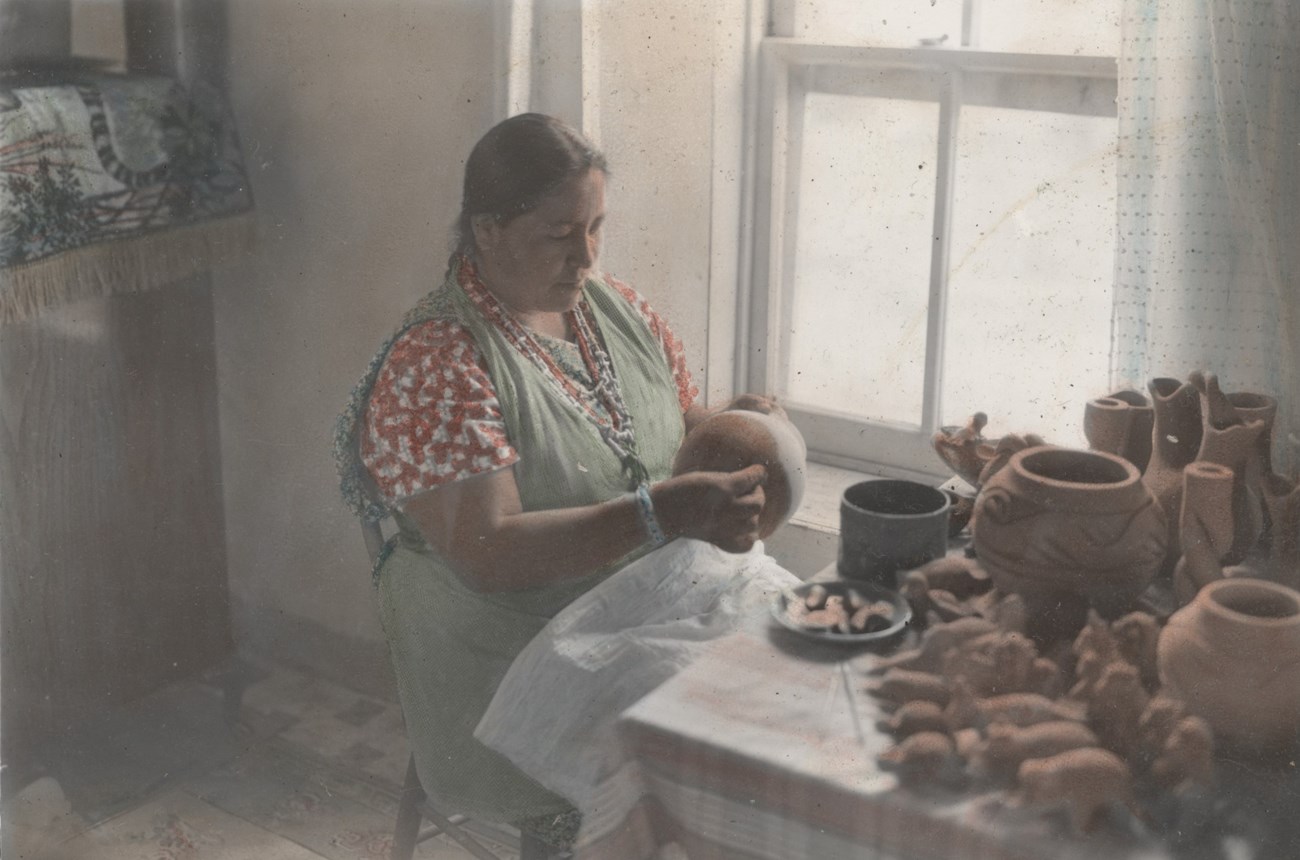
A slip of fine clay is painted onto the pot to form a canvas for the design elements.

Step 10: Adding Design Elements
Tafoya used yucca paint brushes to apply mineral paints to create design elements. Pueblos use distinctive color slips. Each pueblo has its own designs and forms, as do individual potters.
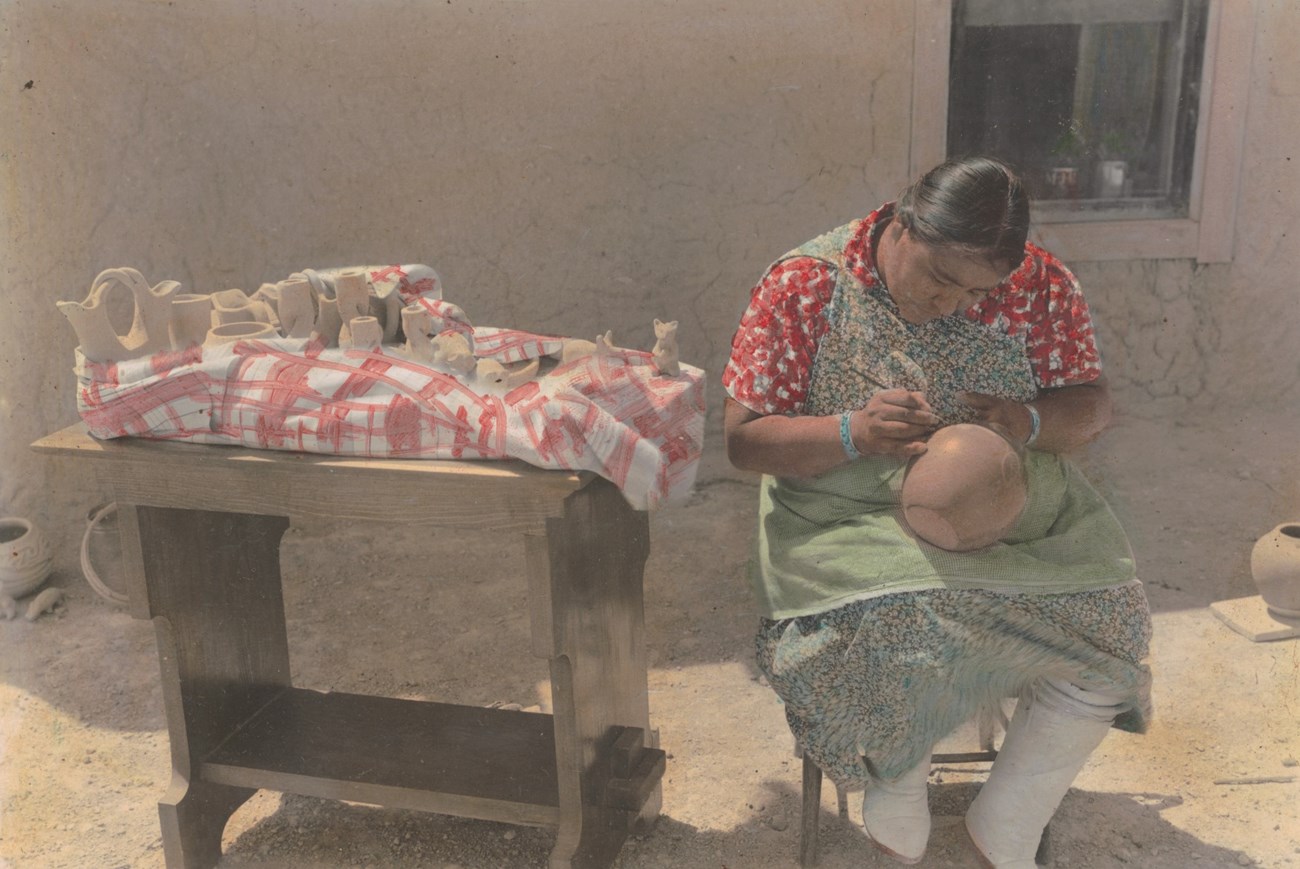
Step 11: Firing the Pot
Traditional Santa Clara pottery is fired outdoors, usually using dried cow dung for fuel. The pottery is red before firing. To get a black finish on the pot, Tafoya smothered the fire in dried, powdered horse manure.
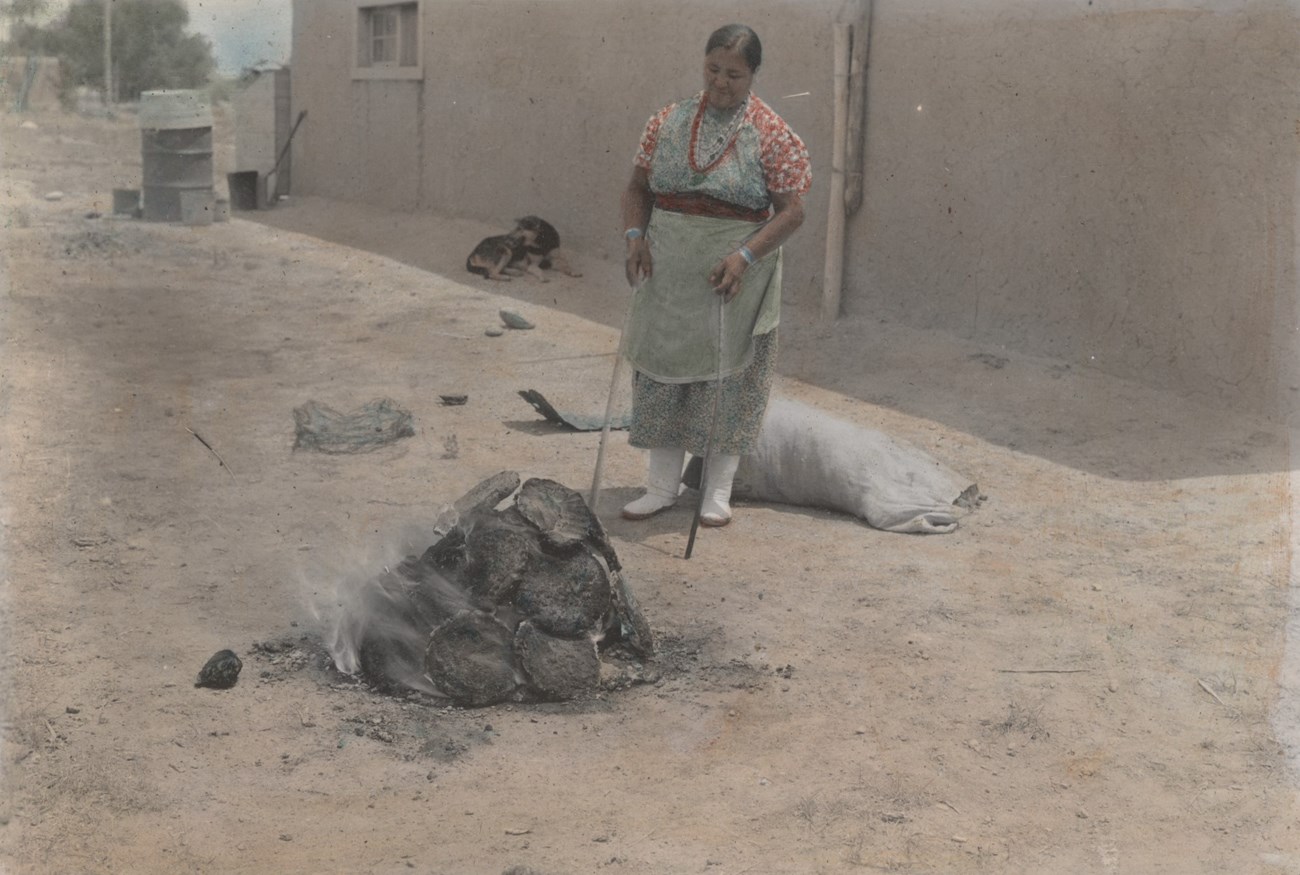
It's not clear what arrangements the NPS made with Tafoya for Dodge's film shoot or for the demonstration pots she made for the Bandelier museum about 1940. There is no evidence that she was an NPS employee. It seems more likely that she was paid a flat fee or hired as a day laborer.
It is probable, however, that she was recommended by her sister Pablita Velarde, who was an employee. In 1939 the NPS hired her to paint scenes of pueblo life for the exhibit at Bandelier's museum. The monument’s July 1939, monthly report noted,
The [museum installation] project received a severe setback at the end of June when the services of Pablita Velarde, noted Santa Clara Indian artist, were terminated temporarily. Papers for a WAE [when actually employed] appointment for Miss Velarde are now in process of preparation, and it is hoped that she can again be employed in a few months to finish her fine work in the Ethnology Room at Bandelier.”
It was November before Velarde was able to resume her work on the project. She worked on the exhibits as funding allowed. In total she created more than 70 paintings for the Bandelier museum.
Although Tafoya's work connection with the NPS was short, she is mentioned several times in later SWNM monthly reports, always as a notable visitor.
Sources:
--. (Undated). “How to Make a Pueblo Pot.” Accessed June 12, 2023, at https://www.nps.gov/museum/exhibits/band/potteryStages.html
--. (ca. 1962). “Lagoria: Indian Potter of Santa Clara Pueblo.” Pamphlet.--. (2023). “Legoria Tafoya.” Accessed June 12, 2023, at https://www.eyesofthepot.com/santa-clara/legoria-tafoya.php
Birth, death, and census records on Ancestry.com
National Park Service. (1939, June). Southwestern Monuments Monthly Report, June 1939. NPS History Collection (HFCA 1645). Available digitally at http://npshistory.com/newsletters/sw_mon_rpt/monthly-report_0639.pdf
National Park Service. (1939, November). Southwestern Monuments Monthly Report, November 1939. NPS History Collection (HFCA 1645). Available digitally at https://ia800603.us.archive.org/29/items/southwestmonu1939depa/southwestmonu1939depa.pdf
National Park Service. (1940, January). Southwestern Monuments Monthly Report, January 1940. NPS History Collection (HFCA 1645). Available digitally at https://ia800303.us.archive.org/4/items/southwesternmonu1940depa/southwesternmonu1940depa.pdf
National Park Service. (1941, April). Southwestern Monuments Monthly Report, April 1941. NPS History Collection (HFCA 1645). Available digitally at https://archive.org/details/southwesternmonu1941depa https://ia800702.us.archive.org/7/items/southwesternmonu1941depa/southwesternmonu1941depa.pdf
Tags
- bandelier national monument
- nps history
- nps history collection
- native american
- native american art
- native american artisans
- santa clara pueblo
- hfc
- photography
- exhibit
- photography exhibit
- legoria tafoya
- women
- women and the arts
- women artists
- native american women
- native american pottery
- pottery
- native american culture
- native american handicrafts
- native american participation
